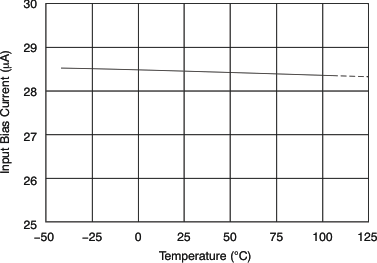SBOS765 January 2016
PRODUCTION DATA.
- 1 Features
- 2 Applications
- 3 Description
- 4 Revision History
- 5 Pin Configuration and Functions
- 6 Specifications
- 7 Detailed Description
- 8 Application and Implementation
- 9 Power Supply Recommendations
- 10Layout
- 11Device and Documentation Support
- 12Mechanical, Packaging, and Orderable Information
Package Options
Mechanical Data (Package|Pins)
- DCK|6
Thermal pad, mechanical data (Package|Pins)
Orderable Information
6 Specifications
6.1 Absolute Maximum Ratings
over operating free-air temperature range (unless otherwise noted)(1)| MIN | MAX | UNIT | ||
|---|---|---|---|---|
| Supply voltage | 7 | V | ||
| Analog inputs, VIN+, VIN–(2) | Differential (VIN+) – (VIN–) | –26 | 26 | V |
| Common-mode(3) | GND – 0.3 | 26 | ||
| Output(3) | GND – 0.3 | (V+) + 0.3 | V | |
| Input current Into all pins(3) | 5 | mA | ||
| Temperature | Operating, TA | –40 | 125 | °C |
| Junction, TJ | 150 | |||
| Storage, Tstg | –65 | 150 | ||
(1) Stresses beyond those listed under Absolute Maximum Ratings may cause permanent damage to the device. These are stress ratings only, which do not imply functional operation of the device at these or any other conditions beyond those indicated under Recommended Operating Conditions. Exposure to absolute-maximum-rated conditions for extended periods may affect device reliability.
(2) VIN+ and VIN– are the voltages at the IN+ and IN– pins, respectively.
(3) Input voltage at any pin can exceed the voltage shown if the current at that pin is limited to 5 mA.
6.2 ESD Ratings
| VALUE | UNIT | |||
|---|---|---|---|---|
| V(ESD) | Electrostatic discharge | Human-body model (HBM), per ANSI/ESDA/JEDEC JS-001(1) | ±2000 | V |
| Charged-device model (CDM), per JEDEC specification JESD22-C101(2) | ±1000 | |||
| Machine model (MM) | ±200 | |||
(1) JEDEC document JEP155 states that 500-V HBM allows safe manufacturing with a standard ESD control process.
(2) JEDEC document JEP157 states that 250-V CDM allows safe manufacturing with a standard ESD control process.
6.3 Recommended Operating Conditions
over operating free-air temperature range (unless otherwise noted)| MIN | NOM | MAX | UNIT | ||
|---|---|---|---|---|---|
| VCM | Common-mode input voltage | 12 | V | ||
| VS | Operating supply voltage (applied to V+) | 3.3 | V | ||
| TA | Operating free-air temperature | –40 | 105 | °C | |
6.4 Thermal Information
| THERMAL METRIC(1) | bq500100 | UNIT | |
|---|---|---|---|
| DCK (SC70) | |||
| 6 PINS | |||
| RθJA | Junction-to-ambient thermal resistance | 227.3 | °C/W |
| RθJC(top) | Junction-to-case (top) thermal resistance | 79.5 | °C/W |
| RθJB | Junction-to-board thermal resistance | 72.1 | °C/W |
| ψJT | Junction-to-top characterization parameter | 3.6 | °C/W |
| ψJB | Junction-to-board characterization parameter | 70.4 | °C/W |
| RθJC(bot) | Junction-to-case (bottom) thermal resistance | N/A | °C/W |
(1) For more information about traditional and new thermal metrics, see the Semiconductor and IC Package Thermal Metrics application report, SPRA953.
6.5 Electrical Characteristics
at TA = 25°C, V+ = 5 V, VIN+ = 12 V, and VSENSE = VIN+ – VIN– (unless otherwise noted)| PARAMETER | TEST CONDITIONS | MIN | TYP | MAX | UNIT | ||
|---|---|---|---|---|---|---|---|
| INPUT | |||||||
| VCM | Common-mode input range | TA = –40°C to +105°C | 0 | 20 | V | ||
| CMR | Common-mode rejection | VIN+ = 0 V to 20 V, TA = –40°C to +105°C |
100 | 120 | dB | ||
| VOS | Offset voltage, RTI(1) | ±5 | ±150 | μV | |||
| dVOS/dT | Offset voltage, RTI vs temperature | TA = –40°C to +105°C | 0.1 | 0.5 | μV/°C | ||
| PSR | Power-supply rejection | V+ = 2.7 V to 6 V, VIN+ = 18 V | ±0.1 | μV/V | |||
| IB | Input bias current | 28 | μA | ||||
| IOS | Input offset current | ±0.02 | μA | ||||
| OUTPUT | |||||||
| G | Gain | 49 | 50 | 51 | V/V | ||
| Maximum capacitive load | No sustained oscillation | 1 | nF | ||||
| VOLTAGE OUTPUT(2) | |||||||
| Swing to V+ power-supply rail | RL = 10 kΩ to GND, TA = –40°C to +105°C |
(V+) – 0.05 | (V+) – 0.2 | V | |||
| Swing to GND | RL = 10 kΩ to GND, TA = –40°C to +105°C |
(VGND) + 0.005 | (VGND) + 0.05 | V | |||
| FREQUENCY RESPONSE | |||||||
| GBW | Bandwidth | CLOAD = 10 pF | 80 | kHz | |||
| SR | Slew rate | 0.4 | V/μs | ||||
| NOISE, RTI(1) | |||||||
| Voltage noise density | 25 | nV/√Hz | |||||
| POWER SUPPLY | |||||||
| VS | Operating voltage range (applied to V+) | TA = –40°C to +105°C | 2.7 | 6 | V | ||
| IQ | Quiescent current | VSENSE = 0 mV | 65 | 100 | μA | ||
| TA = –40°C to +105°C | 115 | ||||||
| TEMPERATURE RANGE | |||||||
| Specified range | –40 | 105 | °C | ||||
| Operating range | –40 | 125 | °C | ||||
(1) RTI = Referred-to-input.
(2) See typical characteristic curve, Output Voltage Swing vs Output Current (Figure 1).
6.6 Typical Characteristics
performance measured at TA = 25°C, V+ = 5 V, and VIN+ = 12 V (unless otherwise noted)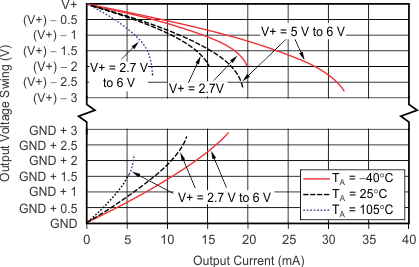
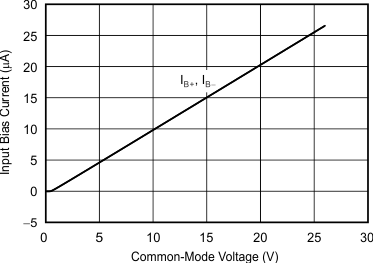
| V+ = 0 V |
(Shutdown)
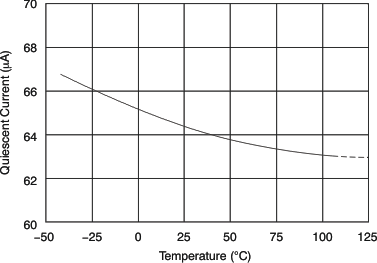
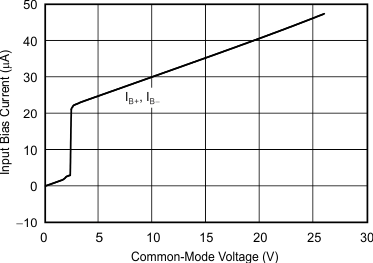
| V+ = 5 V |
